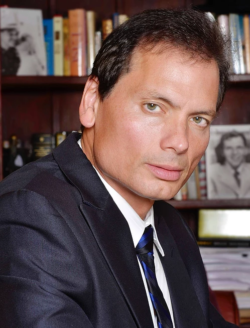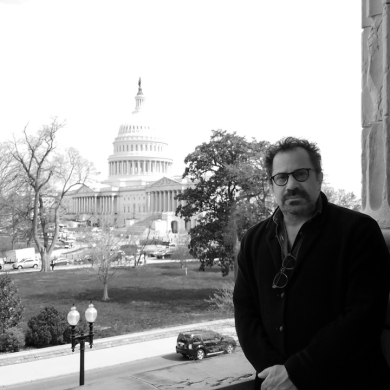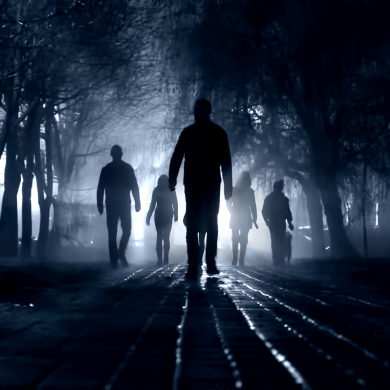Published Date: 10-14-20
By Justin Sanders
You might think that the jobs of actor and doctor are colossally, incompatibly different. That not only do they have nothing to do with each other, but that each is rife with its own tremendous challenges and time commitments. “Surely,” you might be thinking, “it’s difficult enough pursuing just one of these demanding professions with any kind of sustained success. Pursuing both would be well-nigh impossible.”
For you, sweet doubting Thomas, Dr. Rico Simonini has a message:
“Look at Anton Chekhov, Somerset Maugham, and Arthur Conan Doyle,” he told CreativeFuture. Three doctors, three creative powerhouses whose contributions show just how possible it is to not only pursue both medicine and creative work but to do both at a very high level.
For contemporary examples, look no further than George Miller, who worked as a medical doctor in Australia before becoming the filmmaker behind instant classics such as Mad Max: Fury Road and Happy Feet.
Simonini is further proof positive. A well-known cardiologist at Cedars-Sinai, he started taking acting classes on the side while conducting medical research in San Francisco. Within two months of moving to Los Angeles to work at Cedars, a patient “was asking me to read a script out loud right there in my office when I was supposed to be examining him,” he said.
That was the start of a run that included leading roles in plays ranging from Glengarry Glen Ross to A Few Good Men. Along the way, Simonini built an IMDB resume that might be as long as the number of patients in his practice – and, in 2018, he produced his first feature film, Frank and Ava.
Adapted from a play by Willard Manus, Frank and Ava tells the story of the tempestuous romance between Sinatra and screen siren Ava Gardner. In addition to adapting the screenplay himself and raising the money for it, Simonini also somehow found time to play the main character, squeezing in shooting days, wherever he could, over a period of 15 weeks.
Though on acting hiatus like everyone else during the pandemic, Simonini is as busy as ever at his clinic, where many of his patients have COVID-19. He took a break from the tough, heroic work of keeping people alive to tell us about drawing inspiration from his Sinatra-like father, working with Harry Dean Stanton, and how making a low-budget film become a reality is all about “being dedicated to something and paying attention to details… And, trying not to compromise.”

JUSTIN SANDERS: How did you become interested in medicine?
RICO SIMONINI: I grew up in a five-room flat in Brooklyn, where the sounds were either of cooking, or my dad watching the football or baseball games that he bet most of his tips from his restaurant job on, or my mom yelling at my dad when those bets didn’t work out, which was 99% of the time.
So, to escape, I would go to the public library three blocks away. Books were my escape. I remember trying to get through encyclopedias and books on travel and books on history – and then, one day, I found this book called Your Heart and How it Works. It showed a cartoon of a guy standing on the earth with his arteries coming out of his chest and going around the moon. The message was that if you took all the arteries in your body and put them end to end, including the capillaries, they would stretch from the earth to the moon three times.
I thought, “What a cool thing to learn about. It was then that I realized I liked medicine and science.”
JS: Did you always know you wanted to be a cardiologist?
RS: In med school, I thought I was going to be an orthopedic surgeon. I loved sports because I watched them with my dad, but I wasn’t really athletic enough to play.
Then my dad had a heart attack. I raced to the ER he was at, but the ER doctor didn’t want to treat him. He wanted to transfer him to a hospital with a cardio catherization lab, which is a lab where they put a balloon in and open up the artery.
There was a clot-dissolving drug back then called TPA. It caused bleeding in about 10% of people, but I suggested we try it. The doctor said, “I don’t feel comfortable using that drug. It’s expensive, dangerous, and I’d rather wait for a bed and admit your father.” I said, “He doesn’t have that kind of time.”
Then I got kind of aggressive because I was really worried. I said, “Listen, my father knows some pretty scary guys. If you don’t give him the TPA, I’ll call them. How about that?”
The guy turned white as a ghost and brought out the medicine, and I watched my dad’s chest pain go away within minutes. I decided at that moment, “I’m going to be a cardiologist and save lives.”
From that point on, I helped my dad survive three heart attacks, a stroke, lung cancer, and an aneurism. Sometimes he made me regret it. He was an exasperating, charming, charismatic guy who had terrible habits. He loved to gamble – and he threw his money at every pretty skirt he could find.
JS: So, not so different from Frank Sinatra…
RS: When I got the role of Sinatra – in the Actors Studio’s production of Willard Manus’ original stage play, Frank and Ava – all the other actors were like, “How are you going to get ready for this role? How are you going to prepare to play an iconic character like Frank Sinatra?”
I said, “I’m not playing an iconic character. I’m playing a blue-eyed Italian man who had a never-say-never mentality, who was kind of fearless, who knocked around with mob guys, loved women, and was very charming. That’s kind of my dad. My dad was 5’9” with blue eyes. My dad actually waited on Sinatra at the restaurant he worked at.
JS: How did you become interested in acting?
RS: I was exposed to the arts really young and was curious how people told stories on stage. I went to a Jesuit high school in Manhattan that had a strong emphasis on the arts. You had to read plays … Ibsen, Chekhov, and Shakespeare, and you had to stand up and recite monologues.
In San Francisco, while doing research for my medical career, I took some acting classes at American Conservatory Theater. Then I took improv classes and learned not to fake it anymore onstage. And then I came to Los Angeles to be a cardiologist at Cedars-Sinai.
I was in LA two months and a patient said to me, “Have you ever done any acting?” I said, “Do high school plays and improv classes count?” He said, “Read this,” and he had me read a script out loud right there in my office, when I was supposed to be examining him. And then he cast me in a comedy that was produced in a little theater in North Hollywood.
That was the start of it. Patients would bring me scripts. I would do original plays and standard plays. I would audition. I got to play Richard Roma in Glengarry Glen Ross. I got to play the lead in A Few Good Men, McMurphy in One Flew Over the Cuckoo’s Nest, and I got to do Joe Pendleton in Heaven Can Wait.
JS: It seems to me that if one is a doctor who is also interested in acting, you can’t do much better than work at Cedars-Sinai, a world-famous hospital in Los Angeles.
RS: Yeah, go figure. Half of my patients are in show business, either in front of the camera or behind it. I’d say half of my cast in Frank and Ava are patients that wanted to do the movie and were interested in helping me out, and then the other half became patients.
I’m joking but only kind of. One night, I got a phone call from someone who was working on the film with us, and he was having chest pain. He said to me, “You know, I got to work on this project in which the lead actor also happens to be a cardiologist. Then I woke up at 3 in the morning with chest pain and I knew exactly who to call.”
We brought him in and he had a 99% blocked artery. We saved his life. He was meant to work with me.
Then there was Harry Dean Stanton. Frank and Ava was the last movie he appeared in before passing away. I kept him alive for 10 years. The last few were very challenging. Harry was a recalcitrant drinker and smoker. He would not give that up. But I kept him going and he did the film. We actually had to do pickup shots a year after principle shooting, and he had to be hospitalized again. The first thing he said when he came out of the hospital was, “I gotta do that pickup shot for you. Make sure we do it before I croak.” And we did.
JS: You had been acting for years before making a film yourself. Why was Frank and Ava the right project to turn into your first movie?
RS: We did the play for Frank and Ava and it was a great success. I thought it would make a great film someday, but I kept putting it off. Making a movie, as you know, is a very daunting task, and also trying to find money is difficult. That journey is filled with a lot of pretenders and a lot of people who waste your time and who are trying to capitalize on your enthusiasm.
Right around this time, my dad got sick for the last time. I went to see him before he died, and, in the last moments of his life, I played Sinatra songs for him. He never got to see me in the play about Sinatra. When I came back to LA, I started telling my Hollywood friends that I really wanted to make the play into a film. And I was able to raise money to do it.
JS: How did you go about financing the film?
RS: I have a lot of very supportive friends, many of whom are in the film business, and they chipped in. The movie was shot piecemeal, because I didn’t have all the money at once. It was shot over about 15 weekends across a year. Raise money, shoot. Raise money, shoot.
I was trying to do it the conventional way, meaning you go out with a script you like and try to get a production company attached. But if you do a film that way, two things are guaranteed: 1) You’ll never get to play a lead role in the movie, unless you’re a star, and 2) you’ll have zero control over the movie. A lot of times while trying to put together funding that way, I’d be talking to someone who would say, “It’ll be great Rico, there’s even a doctor role you can play.”
I would have to say, “No, that’s not why I’m doing this – to play a doctor with six lines.”
That’s why I decided to do this low budget, on my own.
JS: Any tips for other filmmakers working with a low budget?
RS: Find things at a discount. You would never guess from watching Frank and Ava that it’s low budget – because of the deals I got. You can go to Hollywood Cars Forever and rent vintage cars for a few thousand dollars per day – for each car – or you can go to Bob’s Big Boy on a Saturday morning, when vintage car enthusiasts come to show off their cars, and give 10 guys a hundred dollars apiece and get 10 cars in your shot for the price of one.
Here’s another example: We shot for a couple days in Rome. I speak Italian so I was able to get crowds to stand in shots in public spaces. I got hotels to donate their honeymoon suites to shoot in. I called Italian actresses I knew and they hooked me up with line producers. There was an Italian crew who was supposed to film the James Bond movie Spectre, but they were delayed. So, I hired the crew for a fraction of what they normally get paid – because they were just sitting around waiting for their film to be shot.
So, we shot maybe 30 pages in two days in Italy – outdoor locations, fountains, the cobblestone streets of Rome, and also scenes inside this beautiful hotel. And I made it all happen by making a few phone calls and getting a couple referrals.
It’s all about thinking out of the box, figuring out ways to get things at a value and maximizing locations.
JS: How stressful was it to be working multiple roles in front of the camera and behind it?
RS: Besides being the lead actor, I was the producer and the writer. So, any time there was a problem – like an actor’s car getting towed or wardrobe not fitting, or there’s not enough pizza for the extras – my line producer and my assistant would come up to me, sometimes literally a minute before we started shooting, saying things like, “We need more money.”
Rather than try and separate the two worlds, I brought them together: The movie is about Frank at a very stressful time of his life, when the government was after him, and the studios were after him. So, I let all that stuff, on screen and off, just wash over me – and whenever the cameras rolled, Frank always looks stressed out. If I got angry at what was happening on the production side, I let that anger come out on camera, and it helped create the right amount of tension in a lot of scenes.
JS: As the writer, how did you go about adapting the original play into a screenplay?
RS: It’s all about choosing what to include and what to leave out. That’s why I chose the period of 1949 to 1953 – in 1949, Frank was washed up. He was no longer the skinny crooner that everybody swooned for. He was a scandalous, adulterous, mafia-carousing “liberal”. Nobody wanted any part of him. And on top of that, he suffered a vocal cord hemorrhage and his voice changed. He was doomed to singing in bad night clubs, and on something called “television” – which, in 1950, was like saying you can only do community theater.
That’s when he meets Ava Gardner. She was 24 years old; she had already been married to both Mickey Rooney and Artie Shaw and she was dating Howard Hughes, one of the most powerful men in the world. Frank falls for her. He doesn’t have two nickels to rub together. All he has is his reputation and his conviction that he wants her, and he wants to get his career back. Nobody wanted to give him a shot and nobody thought he had a shot with Ava.
JS: Nobody is getting a shot at all right now either, because film and television are on lockdown – but production seems to be slowly, but surely, coming back. Do you think you’ll do more filmmaking once the time is right?
RS: I think next time I’ll have someone be on the front lines with me on the production side. I made some rookie mistakes with Frank and Ava, so now I know about those going forward. I have other projects I want to do. There is a script I’m trying to develop about the Stonewall Riots, cowritten by the guy who opened the club back then, with a twist that most people don’t know – the Stonewall Inn was actually a money laundering operation for the mob. Let’s just say the mayor and the police department of New York were very upset when they found out how much money was really being made through clubs like the Stonewall Inn.
But yes, to put it simply, I went through the tremendously difficult process of making a film [while also, lest you forget, working as a full-time cardiologist! – Ed.] – and I’m only encouraged to do more!
CREATIVITY.INNOVATION.TOMORROW.



